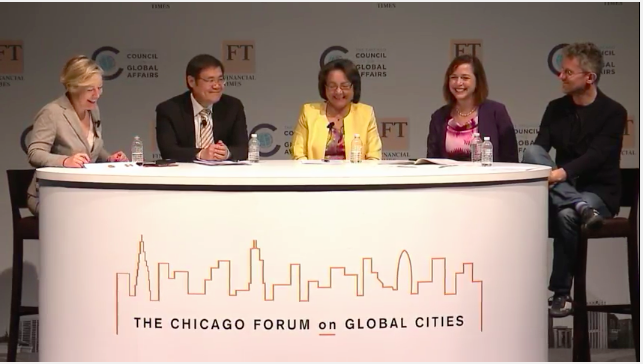
All on hand acknowledged it was truly an “extraordinary” historic moment. And incredibly, it was all coincidence.
Convening just days after the U.S. president announced plans to withdraw from the Paris Climate Accords, the Chicago Council on Global Affairs hosted its third annual Forum on Global Cities. Some 500 delegates from nearly 40 countries, including current and former mayors, prime ministers, ambassadors, architects, developers, city planners, and educators all gathered for the three-day event, co-sponsored by the Financial Times (FT).
“This year just seems different,” said host Amb. Ivo Daalder, president of the Chicago Council and former U.S. Ambassador to the North Atlantic Treaty Organization (NATO). “Before, we asked IF cities will drive the global economy. Now, we ask HOW they will do so,” he told the opening night audience June 7 at the Art Institute of Chicago. (See his opening remarks below.)
Today, if some national leaders seemed to be retreating from the world stage on important issues, Daalder and others were quick to reassure those assembled that cities were already stepping up to fill the void. Said co-host Gillian Tett, FT’s managing editor for the U.S., “I was at an event in Madrid with (former NYC) Mayor Michael Bloomberg when the news broke about the withdrawal from the Climate Accords. He told our group, ‘The dirty little secret is that cities are already leading on this issue.'”
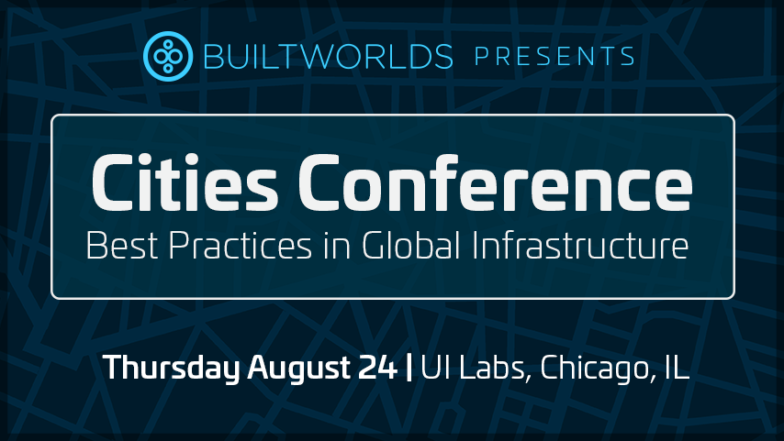
Indeed, two days before the event, Bloomberg, who is now the United Nations Secretary-General’s special envoy for Cities and Climate Change, provided proof. On June 5, he formally submitted a “We Are Still In” declaration to the UN, signed by over 1,000 U.S. governors, mayors, businesses, universities and others that will continue to meet the goals of the Paris Climate Accords. The billionaire also personally pledged $15 million to the U.N. to cover the share that the U.S. had been asked to pay to help administer and coordinate the Paris pact among 195 member nations.
That can-do, ‘outta-my-way’ attitude permeated last week’s Chicago Forum, which also included two speakers from last month’s BuiltWorlds Summit 2017. They were Karen Weigert, the Council’s Senior Fellow on Global Cities, and formerly chief sustainability officer for the City of Chicago; and Carlo Ratti, architect-engineer, and director of the SENSEable City Lab at the Massachusetts Institute of Technology. What follows are five memorable AEC-related takeaways from last week’s event. For much more, review the Twitter feed at #GlobalCities2017.
1. “There is an immense construction wave to come” — Karen Weigert
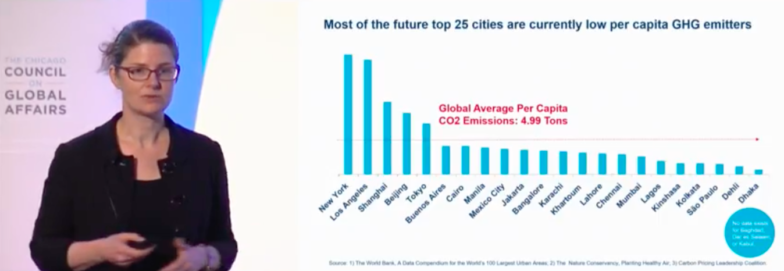
2. “A looming revolution in the internet of things (IoT) is transforming our cities” — Carlo Ratti
“From space, you don’t see countries or states; you see cities,” said Ratti, who noted that Singapore is really at the vanguard of so much technology, especially involving construction and mobility. “Last year, Singapore launched the first fleet of self-driving vehicles ever,” he noted. “You just use an app on your phone to call a self-driving taxi.” (Ratti was a keynote speaker at our Summit.)
3. “Water is one of the biggest challenges faced by our industry” — USG CEO Jenny Scanlon.
Our Ecosmart panels w/ 20% less water and co2 impact #climatechange– “You didn’t know drywall was that exciting, did you?” #GlobalCities2017 pic.twitter.com/wJonj5UeLD
— USG Corporation (@usgcorp) June 8, 2017
“Our vision is to create products that not only reduce CO2 emissions, but also the embodied energy used in the construction sector,” said Jennifer Scanlon, President and CEO of multinational building products giant USG Corp., a founding member of the U.S. Green Building Council (USGBC). “We want to think through the life cycle of all of our products… We recently launched a new sustainable product called EcoSmart (wallboard panels) that uses 25% less water in the manufacturing process… Think about that: If you take the water out of our product, you also reduce the energy needed to produce it. And you create a lighter material that requires less fuel to transport it to the jobsite.”
4. “I’ve always seen the world more as a series of relationships” — Jeanne Gang, architect
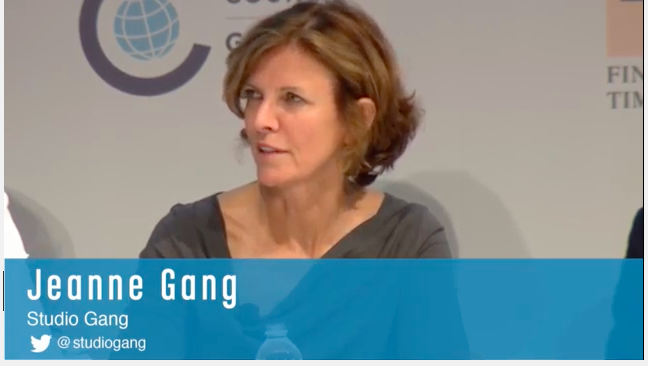
“Architects are always trained to concentrate on their buildings, and rightly so, but really I’ve always seen the world as a series of relationships and tried to look beyond those boundaries,” said architect Jeanne Gang, whose firm Studio Gang has developed the “Polis Station” concept to help disarm arguably the most contentious relationship in Chicago, that between local law enforcement and community members in high-crime areas. “We had seen elsewhere how firehouses were viewed by neighbors as community centers, so that is what we have tried to do here.” One simple idea to soften the typical ‘fortress’ police station? Adding basketball courts to the surrounding parking lots and encouraging neighborhood use and interaction between the groups.
5. “I very much under-predicted the extent of the urban revival” — Richard Florida, author
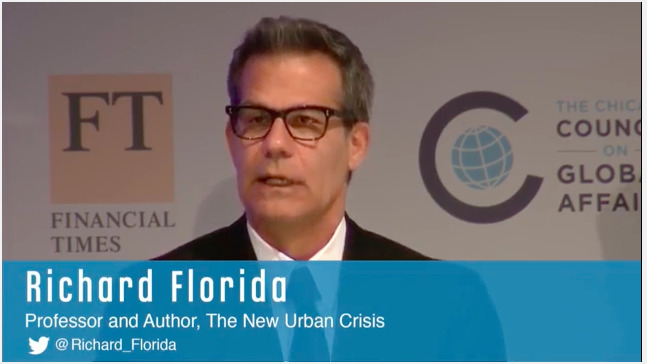 “From 2000 to now, we have seen the top 10% of income earners come back to cities, and the bottom 10% have left,” noted Prof. Richard Florida of the University of Toronto, and author of The New Urban Crisis. “What distinguishes the new urban crisis from the old is that, in the old, we saw the middle class flee to the suburbs… But now, middle-class neighborhoods are being eviscerated. In 1970, 75% of Americans lived in middle-class neighborhoods. Now, less than 40% do. In 203 of 229 Metro areas, the middle class has declined… So we’ve ended up with areas of concentrated advantage surrounded by much larger areas of concentrated disadvantage… And this is going on all over the world, and it’s led to a backlash by those who feel left behind.”
“From 2000 to now, we have seen the top 10% of income earners come back to cities, and the bottom 10% have left,” noted Prof. Richard Florida of the University of Toronto, and author of The New Urban Crisis. “What distinguishes the new urban crisis from the old is that, in the old, we saw the middle class flee to the suburbs… But now, middle-class neighborhoods are being eviscerated. In 1970, 75% of Americans lived in middle-class neighborhoods. Now, less than 40% do. In 203 of 229 Metro areas, the middle class has declined… So we’ve ended up with areas of concentrated advantage surrounded by much larger areas of concentrated disadvantage… And this is going on all over the world, and it’s led to a backlash by those who feel left behind.”
For all the video of all the sessions, visit the Chicago Council’s YouTube page.

Discussion
Be the first to leave a comment.
You must be a member of the BuiltWorlds community to join the discussion.